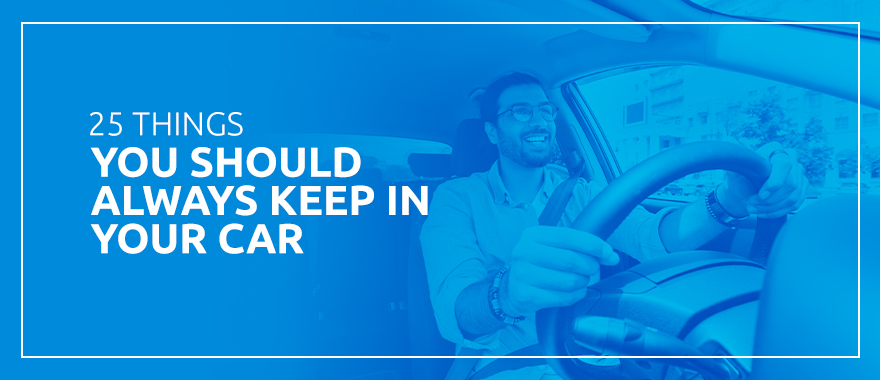
Whenever you travel, you might run into unexpected situations. Understanding what to keep in your car can help you prepare for whatever may come your way. From multi-use items to make your drive more enjoyable to things to keep in your car for emergencies, here are 25 items you should always have in your vehicle, broken down into three categories.
Our first set of items can come in handy in multiple circumstances. Whether you’re wondering what to keep in your car as a woman, teen driver, parent or anyone else, here are 13 multifunctional items anyone should have in their vehicle.
An umbrella is your one-stop shield against multiple types of weather. If you get stuck in an unexpected rain shower or find yourself at a sunny outdoor event with no shade, the umbrella can help keep you dry and cool, plus help prevent sunburn.
A flashlight is another item you can get ample use out of. Your flashlight will be helpful if you find yourself broken down or lost after dark — or even if you attend an event in a rural location and have to find your way back to your car through a series of fields or woods.
We also know how frustrating it can be to drop your phone or wallet down the side of the seat. Even in broad daylight, shadows make it hard to see where your stuff wound up. Pull out your flashlight to help you retrieve it.
We know your car might have limited space, so opt for a compact flashlight that provides just the right amount of illumination.
Most flashlights run on batteries, so you probably want to keep a spare set in your car for when they run out. Having a couple of batteries in your console or glove box can help ensure you always have a working flashlight whenever you need it.
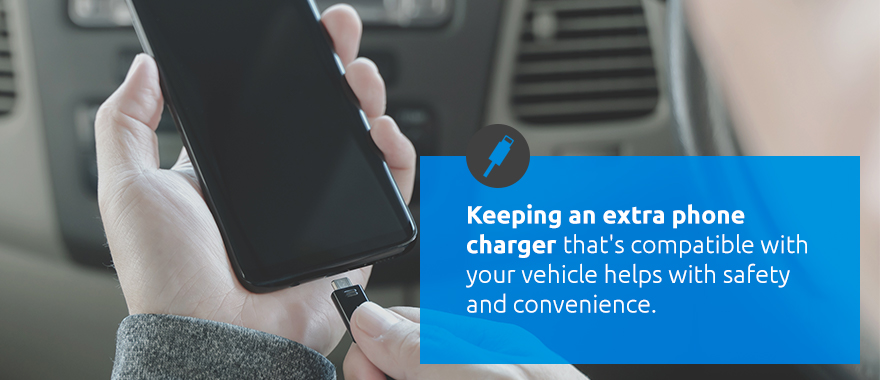
Keeping an extra phone charger that’s compatible with your vehicle helps with safety and convenience. If you’re headed somewhere unfamiliar or far from home, you’ll always have a charged phone to contact someone in case of an emergency. The same is true if you have a breakdown and need to call for help.
Many of us use our phones for GPS and music, which can drain the battery. With an extra phone charger in your car, you can keep your phone plugged in the whole car ride, so you won’t have to worry about a dead battery when you get to your destination.
Paper towels are a quick and easy item to stash in your car, and they serve multiple purposes. If you buy fast food and forget to grab napkins, you can use your paper towels. If you spill a drink or a bit of food on your seat, you’ll have something on hand to clean it up.
A closely related item you might consider keeping in your car is a box of tissues. You’ll always have some on hand if you or your passengers have a runny nose. If a box is too bulky for your car’s limited storage space, consider buying a travel pack of tissues.
A first-aid kit is always good to have on hand in case of minor injuries or cuts that need cleaning. A few items you should keep in your first-aid kit are:
Extra cash and coins are always good to have on hand. If you arrive somewhere that doesn’t accept credit cards, you’ll have your spare cash to get you through. Coins are beneficial for any parking meters you might come across.
If you break down in a rural area and have to wait a while for help to arrive, you might get thirsty. But without any nearby restaurants or stores, you may not be able to walk to grab a drink. Keeping bottled water in your car can help, especially on a hot day.
Similarly, if you’re trying to fix a mechanical problem yourself, you’ll likely work up a thirst. To help keep yourself from getting dehydrated, you can pull out one of your water bottles.
Likewise, keeping a stash of nonperishable snacks in your car can help stave off hunger in the event of a long drive or wait for help. A few examples of snacks you might stock include:
Store food in an airtight container and an adequately sealed cooler to help protect it from the elements. Keep track of how long your chosen snacks will last so you can swap them out for fresh options when needed.
Having wet wipes and hand sanitizer nearby will be helpful when you and your passengers are hungry but want to wash up a bit before eating. You can also use wet wipes to clean up after your kids have a snack in your car. If your kids get food on your car’s interior, have a tub of car wipes to keep your vehicle in pristine condition.
In case of a breakdown, you might need a wipe to remove residue from your hands after examining the problem. We all know how messy mechanical problems can get!
A car blanket serves many purposes for you and your passengers. If your heater goes out or your car breaks down in the winter, the blanket can help keep you warm. Plus, you can use it as a seat cover for any muddy passengers to sit on. If you’re headed to a swimming party or lake and don’t have an extra towel, use your blanket to help keep your seats from getting too wet.
A blanket might also come in handy if passengers prefer different car temperatures. For instance, if you like to keep the air conditioning on high but your spouse gets cold quickly, hand them the blanket. Problem solved!
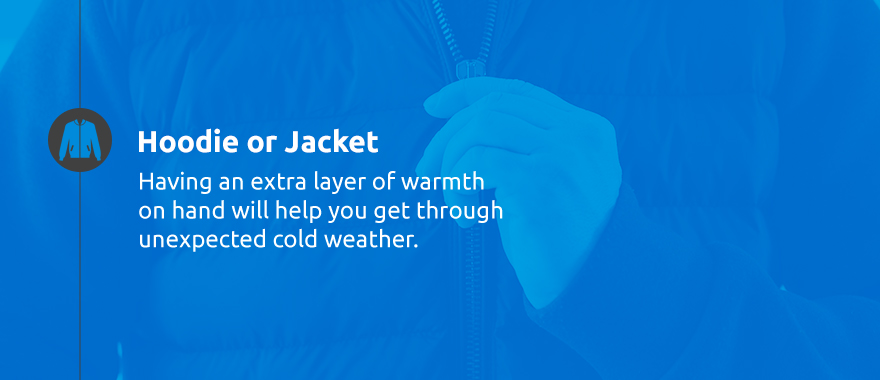
Similarly, keeping a spare hoodie or jacket in your car is always wise. Having an extra layer of warmth on hand will help you get through unexpected cold weather. You never know what the temperature of your destination will be like, even if it’s indoors. Have a hoodie or jacket ready to go in case you need it.
Continuing in the vein of cold-weather preparation, you should keep an extra pair of gloves and socks in your car. If you find yourself in an unexpected snowstorm or a rain shower that leaves your feet soaked, you can slide on your gloves and swap out your wet socks for a fresh pair.
No driver wants to deal with a breakdown, but being prepared for one can go a long way in alleviating stress, keeping you and your passengers safe and getting you back on the road quickly. Consider following our car maintenance tips to help limit your chances of breaking down. However, even the best-maintained vehicles might still experience problems. Be ready by knowing what to keep in your car for emergency maintenance fixes.
A small toolkit can come in handy for many quick fixes. If you want a more space-efficient option, consider keeping a multi-tool device in your car. Either way, these options will provide the most common tools you’ll need to address any potential problems that crop up.
If you’ve been following along with this list, you’ll already have paper towels and wet wipes to clean your hands if you get any grease on them. However, if you’d rather keep your hands from getting dirty in the first place, keep a pair of work gloves in your vehicle. With how grimy your car’s engine and tires can get, you’ll probably be glad to have this protection for your hands.
Many drivers face battery problems at least once in their lives. When your car doesn’t start, be ready with a set of jumper cables. You can also come to the aid of any friends or neighbors parked nearby who may be having trouble.
Any time you experience car trouble while driving and have to pull over, you need to exercise the utmost caution to help you stay safe. Having a set of road flares or reflective triangles will help alert any passing cars to your presence. If you opt for road flares, keep a box of matches or a lighter to light them.
While your road flares or reflective triangles will provide an additional layer of safety, you should also exit the highway whenever possible. No matter what type of road you’re on, pull as far away from the thoroughfare as you can. If you have to wait for help, exit the vehicle and walk even farther away from the road if it’s safe to do so.
Monitoring your tires’ air pressure is critical to staying safe while driving. Keep a tire gauge and air pump on hand to ensure your tires always have the recommended pressure. You’ll need to use your tire gauge more often in the winter, as subzero temperatures can affect air pressure. While many gas stations have air pumps, keeping one in your trunk or glove compartment can come in handy if you’re in a rural area or want the added convenience of not having to find a gas station.
Tire chains, otherwise known as snow chains, are a helpful safety feature in the winter months. If you find yourself driving in an unexpected snowstorm, you can retrieve your snow chains from your vehicle to give your tires an added traction boost. On slippery roads, the traction provided by tire chains can help keep you and your passengers safe.
It’s always wise to keep a spare tire in your trunk. Because some new vehicles don’t come with a spare, double-check that you have one ready to go if you experience a blowout or a flat.
You should also occasionally check your spare tire hasn’t expired. According to Consumer Reports, you’ll usually want to buy a new spare every 10 years.
If you ever need to change a spare tire, you’ll need the proper tools. You should keep a jack and lug-nut wrench in your vehicle. Also, keep a set of wheel wedges on hand to prevent your car from rolling while you change the tire. A small plank of wood can help keep your jack balanced.
Follow your owner’s manual anytime you change a spare, and if you don’t yet know how to change a tire, make sure you review a how-to guide or two.
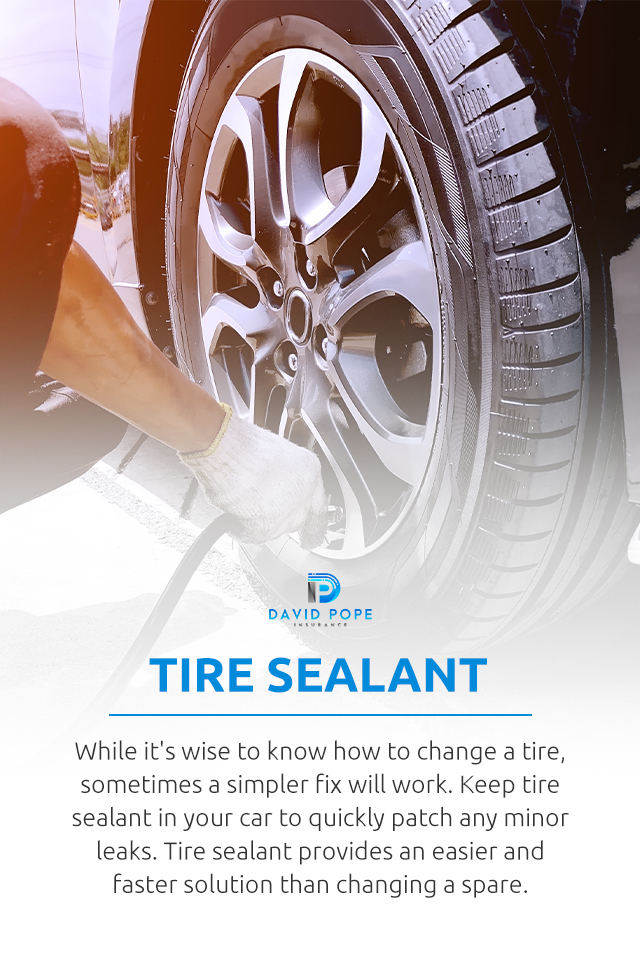
While it’s wise to know how to change a tire, sometimes a simpler fix will work. Keep tire sealant in your car to quickly patch any minor leaks. Tire sealant provides an easier and faster solution than changing a spare.
If you experience a blowout and can’t navigate your car off the highway and to a safe location, quickly applying tire sealant can give you a fast patch to continue driving to a safer spot. However, still be sure to pull as far off the road as possible and use your flashers and road flares or reflective triangles.
Tire sealant is an excellent temporary solution you can use in an emergency. Ensure you apply it correctly to help prevent further damage to your tire.
If you run into trouble and have to walk to get help, an extra pair of shoes will be helpful. Save yourself from walking down the road in dress shoes by having a spare pair of tennis shoes or other comfortable shoes in your vehicle.
Once you’ve stocked your car with all the practical tools you might need, double-check your glove box for the following essential documents that should always be in your vehicle.
You’ll need proof of car insurance in an easy-to-reach spot in case of any accidents or if you get pulled over. You’ll want to ensure your insurance policy is well-suited for your unique situation. Insurance companies provide many types of auto coverage, and there’s no one-size-fits-all solution. When checking to ensure you have updated proof of car insurance in your vehicle, take the opportunity to review your policy to see if you might like to update it.
In addition to your insurance card, you’ll need a few other files in your vehicle. We’ve mentioned referencing your owner’s manual throughout this list, so keep that handy. The manual will provide vehicle-specific guidance on changing a tire, and it can explain any indicators that pop up on your dash. Run into problems with the radio or digital screen? Turn to your owner’s manual for help.
Finally, always make sure your registration is in the vehicle. Like your insurance, you’ll need this any time you get pulled over, so keep it in an easy-to-reach spot.
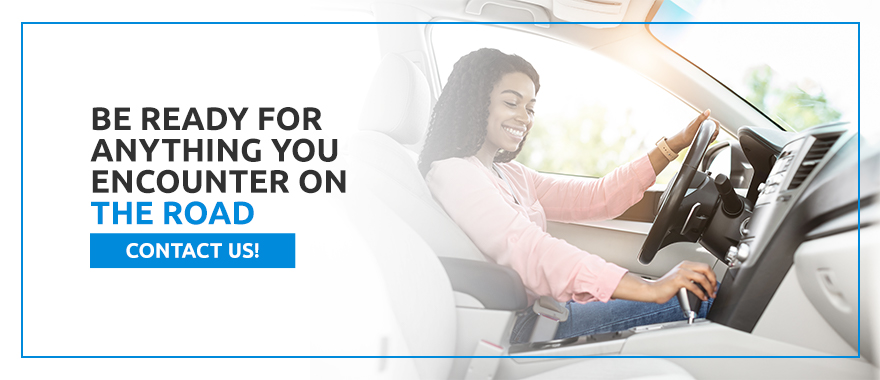
At David Pope Insurance Services, LLC, we understand the many unexpected situations you can encounter on the road. We’re here to help you prepare so you and your family can stay as safe as possible.
Having the right car insurance is one of the best ways to prepare for unexpected events while driving. We provide flexible quotes to suit your needs while providing the peace of mind you need. Learn more about our auto insurance policies, or read our advice on how to save on car insurance today!